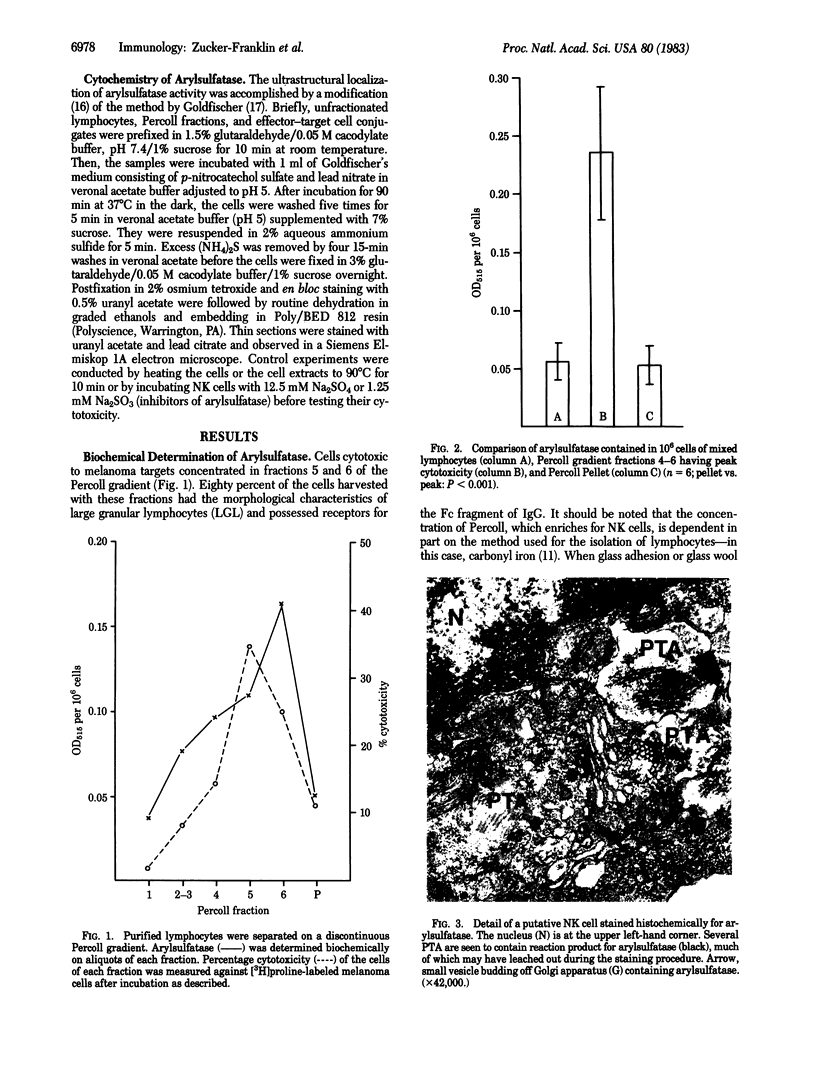Abstract
Ultrastructural cytochemistry of natural killer cells enriched by Percoll gradient centrifugation showed them to possess arylsulfatase (aryl-sulfate sulfohydrolase, EC 3.1.6.1). The enzyme was located in vesicles, granules, and the parallel tubular arrays, organelles characteristic for cytotoxic lymphocytes. Biochemically, peak enzyme activity correlated with the Percoll fractions containing cells with cytotoxicity for melanoma target cells. Treatment of natural killer cells with Na2SO4, a competitive inhibitor of arylsulfatase, suppressed cytotoxicity by almost 50%. Electron microscopy of effector-target cell conjugates, which had been permitted to incubate for only 30 min, disclosed numerous arylsulfatase-positive sites at the points of contact between the effector/target cell membranes. Thus, the enzyme was translocated to the surface before lysis of the target cell was morphologically evident. It is postulated that the parallel tubular arrays play a role in this translocation and that arylsulfatase may function in the degradation of cerebroside sulfate ester components of the target cell membrane to initiate the lytic event.
Full text
PDF




Images in this article
Selected References
These references are in PubMed. This may not be the complete list of references from this article.
- AUSTIN J. H., BISCHEL M. A histochemical method for sulfatase activity in hemic cells and organ imprints. Blood. 1961 Feb;17:216–224. [PubMed] [Google Scholar]
- Abo T., Balch C. M. A differentiation antigen of human NK and K cells identified by a monoclonal antibody (HNK-1). J Immunol. 1981 Sep;127(3):1024–1029. [PubMed] [Google Scholar]
- Bean M. A., Pees H., Rosen G., Oettgen H. F. Prelabeling target cells with 3 H-proline as a method for studying lymphocyte cytotoxicity. Natl Cancer Inst Monogr. 1973 Jun;37:41–48. [PubMed] [Google Scholar]
- Bentfeld-Barker M. E., Bainton D. F. Cytochemical localization of arylsulfatase B in rat basophils and mast cells. J Histochem Cytochem. 1980 Oct;28(10):1055–1061. doi: 10.1177/28.10.7419898. [DOI] [PubMed] [Google Scholar]
- Burns E. R., Zucker-Franklin D., Valentine F. Cytotoxicity of natural killer cells: correlation with emperipolesis and surface enzymes. Lab Invest. 1982 Jul;47(1):99–107. [PubMed] [Google Scholar]
- Carpen O., Virtanen I., Saksela E. Ultrastructure of human natural killer cells: nature of the cytolytic contacts in relation to cellular secretion. J Immunol. 1982 Jun;128(6):2691–2697. [PubMed] [Google Scholar]
- DODGSON K. S., SPENCER B., WYNN C. H. Studies on sulphatases. 12. The arylsulphatases of human tissues. Biochem J. 1956 Mar;62(3):500–507. doi: 10.1042/bj0620500. [DOI] [PMC free article] [PubMed] [Google Scholar]
- Dennert G., Podack E. R. Cytolysis by H-2-specific T killer cells. Assembly of tubular complexes on target membranes. J Exp Med. 1983 May 1;157(5):1483–1495. doi: 10.1084/jem.157.5.1483. [DOI] [PMC free article] [PubMed] [Google Scholar]
- Dourmashkin R. R., Deteix P., Simone C. B., Henkart P. Electron microscopic demonstration of lesions in target cell membranes associated with antibody-dependent cellular cytotoxicity. Clin Exp Immunol. 1980 Dec;42(3):554–560. [PMC free article] [PubMed] [Google Scholar]
- Farooqui A. A., Srivastava P. N. Isolation, characterization and the role of rabbit testicular arysulphatase A in fertilization. Biochem J. 1979 Aug 1;181(2):331–337. doi: 10.1042/bj1810331. [DOI] [PMC free article] [PubMed] [Google Scholar]
- Farooqui A. A. Sulfatases, sulfate esters and their metabolic disorders. Clin Chim Acta. 1980 Jan 31;100(3):285–299. doi: 10.1016/0009-8981(80)90278-8. [DOI] [PubMed] [Google Scholar]
- Frey T., Petty H. R., McConnell H. M. Electron microscopic study of natural killer cell-tumor cell conjugates. Proc Natl Acad Sci U S A. 1982 Sep;79(17):5317–5321. doi: 10.1073/pnas.79.17.5317. [DOI] [PMC free article] [PubMed] [Google Scholar]
- Fujinami N., Zucker-Franklin D., Valentine F. Interaction of mononuclear leukocytes with malignant melanoma. Lab Invest. 1981 Jul;45(1):28–37. [PubMed] [Google Scholar]
- Goldfischer S. The cytochemical demonstration of lysosomal aryl sulfatase activity by light and electron microscopy. J Histochem Cytochem. 1965 Jul-Aug;13(6):520–523. doi: 10.1177/13.6.520. [DOI] [PubMed] [Google Scholar]
- Hudig D., Haverty T., Fulcher C., Redelman D., Mendelsohn J. Inhibition of human natural cytotoxicity by macromolecular antiproteases. J Immunol. 1981 Apr;126(4):1569–1574. [PubMed] [Google Scholar]
- Jatzkewitz H., Mehl E. Cerebroside-sulphatase and arylsulphatase A deficiency in metachromatic leukodystrophy (ML). J Neurochem. 1969 Jan;16(1):19–28. doi: 10.1111/j.1471-4159.1969.tb10339.x. [DOI] [PubMed] [Google Scholar]
- Payne C. M., Glasser L. Evaluation of surface markers on normal human lymphocytes containing parallel tubular arrays: a quantitative ultrastructural study. Blood. 1981 Mar;57(3):567–573. [PubMed] [Google Scholar]
- ROY A. B. The sulphatase of ox liver. 7. The intracellular distribution of sulphatases A and B. Biochem J. 1960 Nov;77:380–386. doi: 10.1042/bj0770380. [DOI] [PMC free article] [PubMed] [Google Scholar]
- Roder J. C., Helfand S. L., Werkmeister J., McGarry R., Beaumont T. J., Duwe A. Oxygen intermediates are triggered early in the cytolytic pathway of human NK cells. Nature. 1982 Aug 5;298(5874):569–572. doi: 10.1038/298569a0. [DOI] [PubMed] [Google Scholar]
- Roder J. C., Kiessling R., Biberfeld P., Andersson B. Target-effector interaction in the natural killer (NK) cell system. II. The isolation of NK cells and studies on the mechanism of killing. J Immunol. 1978 Dec;121(6):2509–2517. [PubMed] [Google Scholar]
- Roder J. C., Pross H. F. The biology of the human natural killer cell. J Clin Immunol. 1982 Oct;2(4):249–263. doi: 10.1007/BF00915064. [DOI] [PubMed] [Google Scholar]
- TANAKA K. R., VALENTINE W. N., FREDRICKS R. E. Human leucocyte arylsulphatase activity. Br J Haematol. 1962 Jan;8:86–92. doi: 10.1111/j.1365-2141.1962.tb06498.x. [DOI] [PubMed] [Google Scholar]
- Timonen T., Saksela E. Isolation of human NK cells by density gradient centrifugation. J Immunol Methods. 1980;36(3-4):285–291. doi: 10.1016/0022-1759(80)90133-7. [DOI] [PubMed] [Google Scholar]
- Tschopp J., Podack E. R., Müller-Eberhard H. J. Ultrastructure of the membrane attack complex of complement: detection of the tetramolecular C9-polymerizing complex C5b-8. Proc Natl Acad Sci U S A. 1982 Dec;79(23):7474–7478. doi: 10.1073/pnas.79.23.7474. [DOI] [PMC free article] [PubMed] [Google Scholar]
- Wasserman S. I., Goetzl E. J., Austen K. F. Inactivation of slow reacting substance of anaphylaxis by human eosinophil arylsulfatase. J Immunol. 1975 Feb;114(2 Pt 1):645–649. [PubMed] [Google Scholar]
- Zucker-Franklin D. The percentage of monocytes among "mononuclear" cell fractions obtained from normal human blood. J Immunol. 1974 Jan;112(1):234–240. [PubMed] [Google Scholar]





